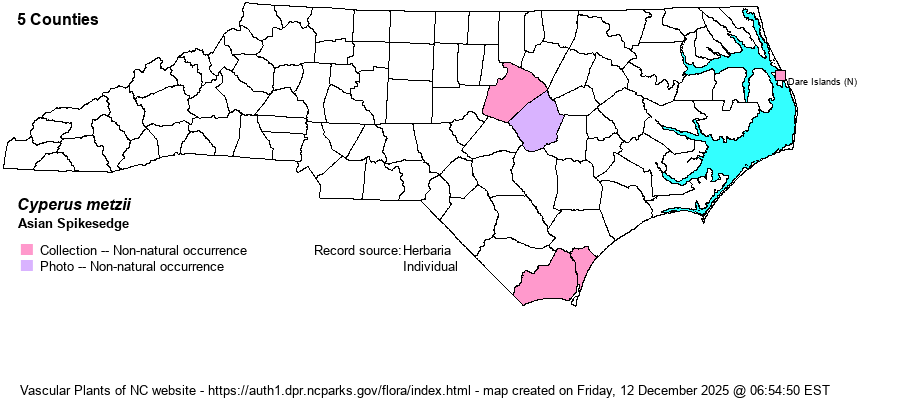| Author | (Hochstetter ex Steudel) Mattfield & Kuekenthal | |
| Distribution | First discovered in NC in 2020 by Mark and Myra Basinger in southeastern Brunswick County (SERNEC collection), plus another 2020 collection by one or both Basingers in neighboring New Hanover County. Another collection was made in 2021 by Larry Chen in Dare County at the lawn of Outer Banks Hospital, Nags Head. He submitted a report to iNaturalist (IDed there by John Kees) and his photographs have been confirmed by Richard Carter, a published expert in this genus of sedges. In Fall 2022, Bryan England collected the species in the Piedmont, in Wake County (NCU). In October 2024, David Parker photographed a population in a yard in Johnston County.
Native of tropical Asia; scattered records in the U.S. north to SC, and now to NC. | |
| Abundance | Very rare, with just several collections. | |
| Habitat | Lawns, "Disturbed sandy soil" at a park. | |
| Phenology | Fruiting when photographed in mid-October. | |
| Identification | Sedges formerly in the genus Kyllinga are quite similar and need to be keyed carefully. Use the key in Weakley (2020) or in Carter et al. (2016). Asian spikesedge often has a yellowish green tinge to the plant and the fruiting head is tan color or mixed tan-green. Notable are the ragged (deeply cut) edges of the floral scales. | |
| Taxonomic Comments | A synonym is Kyllinga squamulata. BONAP
The genus Cyperus is mostly tropical and warm-temperate in distribution; thus, in NC it is much commoner in the Coastal Plain than in the Mountains and Piedmont. Most species have 1-few flowering stems (culms) from grasslike basal leaves, plus a few stem leaves. At the summit is an inflorescence of very open and branched, or tightly packed, spikes, varying among species from brown to golden brown to straw-color to reddish. The arrangement of the spikelets is important, whether like a hand (digitate) or in paired or alternate rows (pinnate); as is the shape of the achene (seed), whether bi-convex in cross-section or triangular. As a group, Cyperus tends to be weedy and readily enters disturbed ground; this is true for many natives as well as all the aliens. In recent years, following DNA research, the genus has incorporated several genera that in RAB (1968) or other manuals were separate: Hemicarpha, Lipocarpha, and Kyllinga. | |
| Other Common Name(s) | | |
| State Rank | SE | |
| Global Rank | G5 | |
| State Status | | |
| US Status | | |
| USACE-agcp | | |
| USACE-emp | | |

